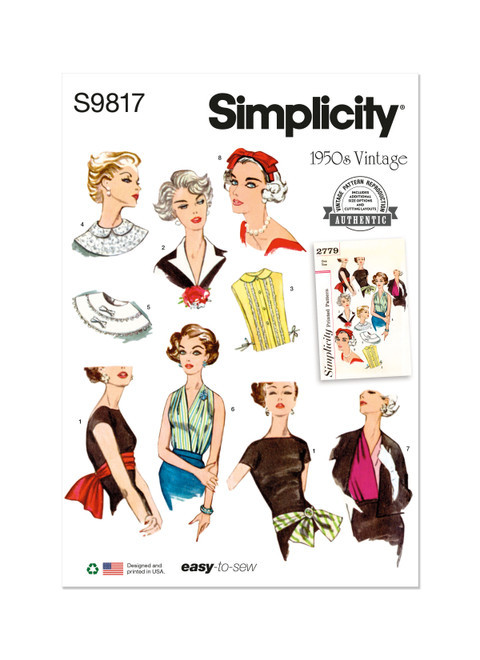#collarsandcuffs
Text

Nope, That Is Not a Blouse: Simplicity 9817
This set of re-issued accessories from the 1950s has some expected items and some unusual ones. Collars and cuffs that could be switched out, and thus give some variety to one dress, were a standard feature from at least the late 19th Century onward. Here, you see two rounded versions and one designed to look like lapels on a blouse.
Hair bows too date way back although this is a bow on a headband which was a newer look in the 1950s. The bias-cut sash, which you see on the bottom row in red and in green stripes is also a traditional idea and here it is pulled through a buckle.
A newer idea was the dickey that looked like a blouse. These were often recommended during World War II when fabric was hard to get. A woman could use just a small bit of fabric, maybe a remnant from a bigger project, and could give a new look under a dress that could not be replaced. It was also possible, as it is suggested by these illustration to wear a dickey under a suit as you see in the lower right hand corner with a two-color version. Yes, it looks like a wrapped blouse or a halter top, but this item actually has back and no sides and ties at the waist. I am not sure I see the point unless you had a desperate lack of fabric. Wouldn't it be no more difficult to make a halter top, or a sleeveless blouse? And surely, wearing an actual top would be more comfortable and less awkward, and allow you to doff your jacket if you liked.
You can find this pattern at your local fabric store or online here:
#dressmaking#sewing#diy#making#makers#dresshistory#costumehistory#fashionhistory#vintagesewing#vintagesewingpatterns#sewingpatterns#1950sfashions#simplicitypatterns#simplicity9817#garmentdesign#fashiondesign#historyofgarmentdesign#collarsandcuffs#dickey#vintagefashion
27 notes
·
View notes
Photo


Spring Cutaway Collar, Can it Be for the Office? Butterick 6870
This re-issued pattern from the 1950s shows the two silhouettes which became popular in 1947 when Christian Dior of Paris launched his post-war New Look. Both have soft shoulders and small waistlines, while the best known as the look of the 1950s is the full-skirted silhouette, and the lesser known the slender silhouette was very popular as well, and it needed a back kickpleat to make movement possible.
Here both dresses share what they call a “cutaway cape collar” which is why I am puzzled at the detachable collar on the slender, navy-blue look. Navy blue and detachable collars were a common look for the basic dress, a dress that could have cuffs, collars, accessories, and even buttons switched out for variety in a small wardrobe. Such a wardrobe was essential to the college woman and to the wage-earning office worker. But such a low-collar would have been considered a bit flirty for the office in the 1950s. And it is shaped so that putting a sweater or short jacket would be awkward. So office workwear, party dress, or a strange hybrid? Hard to say.
The large-skirted version is clearly party wear, notice the ribbon in the back of the collar which serves no purpose except to add to the swaying movement of the woman wearing it. It seems a wonderful choice for spring weddings, graduation parties, and other celebrations. Crispy fabrics will serve for either silhouette and they recommend shantung, faille, linen, cotton pique and broadcloth; they also recommend crepe, but that does not make a lot of sense as it has a soft drape.
Both have cut-on sleeves, short, or longer with elbow darts. Such sleeves have less movement possible in them, so if you opt for long, consider whether you want to add an underarm gusset--a diamond-shaped piece--which will give you more freedom.
This comes in modern sizes and can be found at your local fabric store or here: https://somethingdelightful.com/butterick/b6870
#1950sfashion#christiandior#newlook#Butterickpatterns#buttericksewingpatterns#butterick6870#springfashions#sewing#dressmaking#vintagedressmaking#vintagedress#vintagefashion#costumehistory#dresshistory#fashionhistory#vintagesewing#making#collarsandcuffs
26 notes
·
View notes